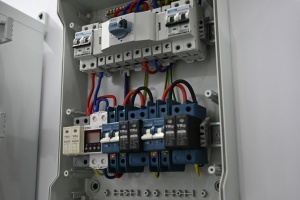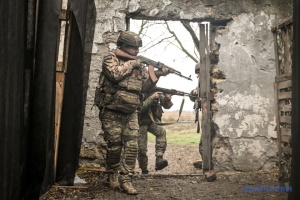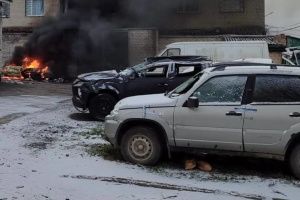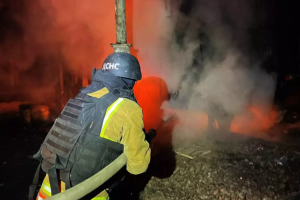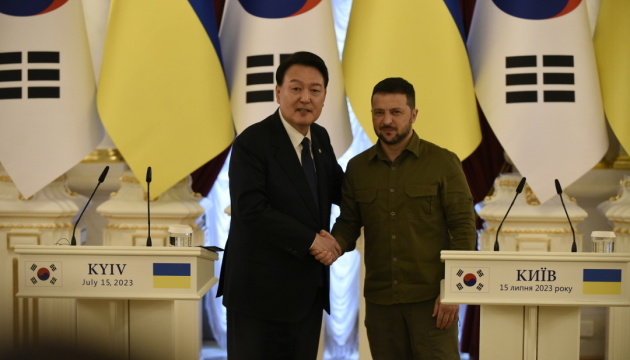
President of Republic of Korea was actually expected in Kyiv for long time
In April, South Korean President Yoon Suk Yeol said he would consider providing Ukraine with weapons, and in July he made an unannounced visit to Kyiv. The event is truly historic, as the leader of this developed country has never visited our country before. However, in this case, we are interested not so much in the political and diplomatic side of Mr. Yoon's visit as in the prospects for defense cooperation between Kyiv and Seoul.
But first...
Tectonic changes: how President Yoon is confidently moving South Korea to the West
The Republic of Korea is a rather specific country. However, according to Artur Kharytonov, president of the "Liberal Democratic League of Ukraine", an expert on East Asia, it is not worth digging deep in this case, because one material is not enough. It is much more important now to understand the trend of the last almost two years, which is extremely positive for us.
"When Russia launched its large-scale invasion of Ukraine, South Korea was led by Moon Jae-in. He and his political force, the "Toburo Democratic Party", advocated and, ultimately, still advocate the so-called "third way" for Korea, that is, non-interference, neutrality, friendship with Russia, and not to irritate Putin and Xi Jinping. However, in March 2022, South Korea held presidential elections, which were won by the candidate of the opposition party "People's Power" Yoon Suk Yeol," the expert says.
Mr. Kharytonov emphasizes that President Yoon is categorically different from his predecessor: "Yoon ran as a pro-American and pro-Japanese candidate. He has firmly stated that he does not share the position of Moon Jae-in, whose previous leadership severely undermined the friendship between Seoul and Washington and Seoul and Tokyo."
Moon Jae-in's previous administration was criticized for flirting with China and being soft on North Korea.
"Moreover, due to his policy of balancing between the main players in the region - the United States and China - Moon decided to refuse to deploy additional US missile defense systems in South Korea, and also limited the country's participation in US defense initiatives," Mr. Kharitonov added.
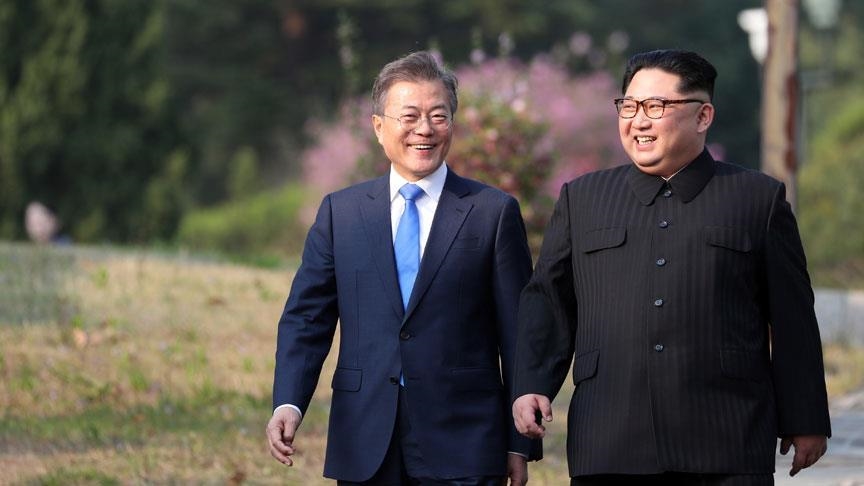
Instead, close cooperation with the United States has become a priority for Yoon Suk Yeol. In particular, he initiated negotiations with the Americans on the additional deployment of THAAD missile systems. Military-technical cooperation programs were also resumed and joint military exercises were agreed upon.
"The United States returned the nuclear umbrella to South Korea. And in return, South Korea promised to fully invest in the American security network," the source emphasizes.
Stabilizing relations with Japan is a significant part of the current president's foreign policy agenda. The two countries have had historical disputes since the Japanese occupation of the Korean Peninsula at the beginning of the last century. In 2015, the two governments signed an agreement to resolve the issue, but the following year, Moon Jae-in's administration again raised the issue of insufficient compensation from Tokyo. The situation escalated so much that it led to the outbreak of a trade war and the restriction of official contacts between Japan and South Korea.
"After coming to power, Yoon Suk Yeol began to normalize relations with Japan. With the mediation of the United States, the process of reconciliation is proceeding, albeit slowly," the expert emphasizes.
The expansion of the military-industrial complex element in South Korea's foreign policy should not be overlooked: "The growth rate of arms exports from Korea is the highest in the world. In 2022, Seoul signed multibillion-dollar arms contracts with Poland, Romania, the Czech Republic, and Australia."
In 2022, the South Korean president was invited to the NATO summit in Madrid for the first time in history.
"Starting in 2023, Yoon Suk Yeol's pro-Western line has further progressed and formalized. The White House, as far as I understand it, has put it this way: The United States is ready to continue to strengthen South Korea's security, and in return, South Korea must change its policy on arms supplies to Ukraine, either directly or through other countries," says Artur Kharytonov.
In April of this year, the South Korean president paid his first visit to Washington in 12 years, where he promised Biden to consider providing Ukraine with weapons.
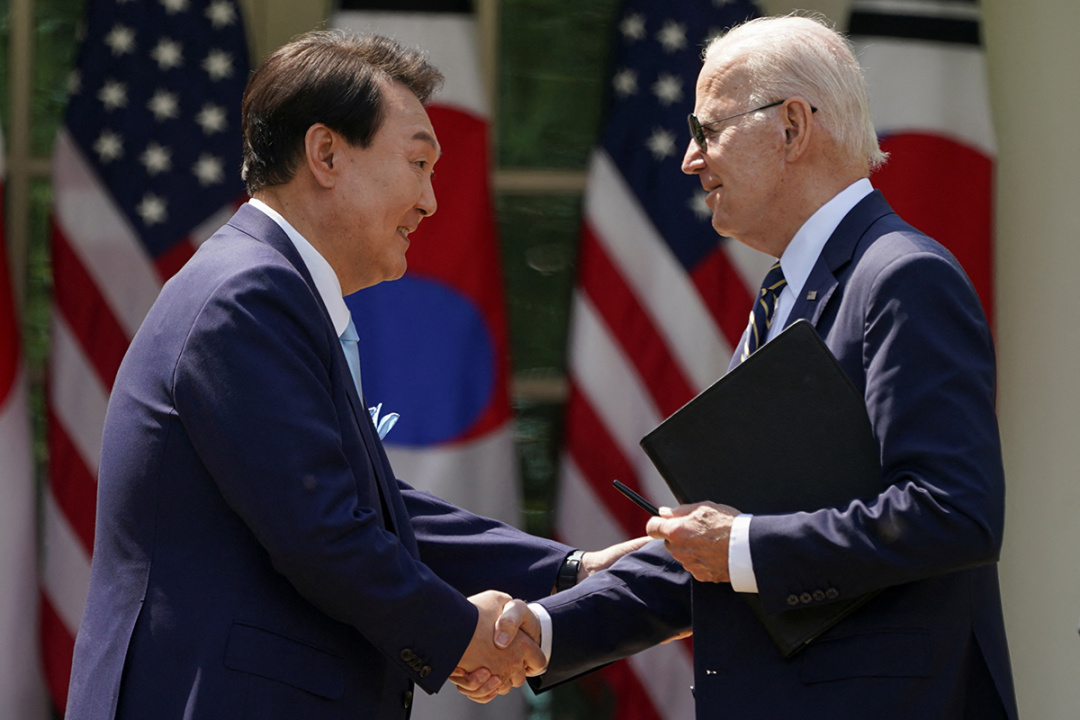
"And in May, First Lady Olena Zelenska visited Seoul. Then there was President Volodymyr Zelensky's meeting with Yoon Suk Yeol on the sidelines of the G7 summit in Hiroshima. Then there was the NATO summit in Vilnius, where the Alliance and South Korea expanded their partnership program," the expert recalls. - "And finally, the historic visit of President Yoon to Kyiv, which was not previously announced. In addition to allocating financial assistance, the South Korean leader also promised to provide Ukraine with demining equipment and ambulances. Is that all? At least from what was officially announced, yes. But..."
Mr. Kharytonov is confident that South Korea will definitely support the European countries that will supply us with weapons. But will there be direct deliveries? There is a nuance: there are still certain legal restrictions in this country.
"For South Korea to be able to directly transfer weapons to Ukraine, they need to change their legislation. Although it is a presidential republic, where the head of state is the head of the executive branch and has quite broad powers, there is also a parliament. And in the parliament, let's just say that President Yoon is not in a very comfortable situation because of the dominance of the previously mentioned Democratic Party. So Yoon may not be able to resolve this issue as quickly as we would like. But it's not all bad. In six months, the country will hold parliamentary elections, and before then, I think Mr. Yoon will come up with something. In any case, South Korea is very important to us in terms of arms and technology. Unfortunately, we have not done enough to develop cooperation over the years. But the war has made its own adjustments, so it's never too late to start," Artur Kharytonov emphasized.
With the exception of nuclear weapons and long-range missiles of strategic importance, South Korea develops and produces almost the entire range of conventional weapons. And since Yoon Suk Yeol allowed the transfer of weapons to Ukraine, our country can count on it.
A lot of weapons: what is the South Korean military-industrial complex?
Between 2017 and 2021, the Korean military industry became the fastest growing among the world's 25 largest arms exporters and, according to the Stockholm International Peace Research Institute, ranked eighth with a global market share of 2.8%.
In 2022, arms exports grew by 140% to a record $17.3 billion. The majority of this amount ($12.4 billion) came from the sale of tanks, howitzers, fighters, and MLRS to Poland. Smaller contracts were also signed with Egypt and the UAE in 2022.
One of the advantages of weapons from South Korea is the possibility of technology transfer. For example, Poland will produce Korean K2 and FA-50 tanks, but with the PL designation. That is, the right to manufacture the technology was purchased, but with its own modernization.
Another example is the Turkish Altay tank, which is to enter service by the end of 2023. Korea participated in the development of the armor, transferred the technology for manufacturing guns, and supplied the power plant and a number of other systems.
According to military analysts, if the pace of development of the South Korean military-industrial complex does not slow down, Seoul could become the fourth largest arms exporter by 2027, overtaking Germany.
"Unlike the states that reduced their armies and equipment and ammunition production capacities at the end of the Cold War, South Korea has maintained a reliable defense supply chain to meet the demand of its own armed forces and defend itself against the DPRK. Eastern European countries were in a hurry to re-equip and modernize their forces after sending Soviet-era weapons to Ukraine, and South Korea became an attractive option," The New York Times writes.
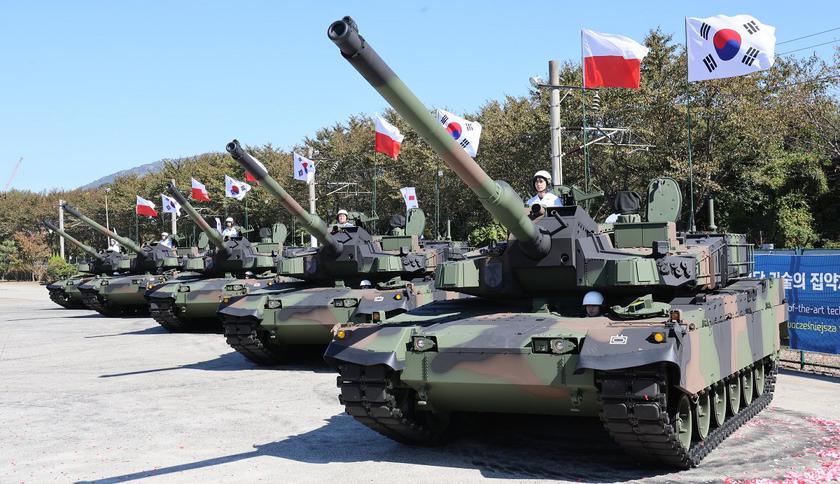
By the way, most of South Korea's weapons are specially designed to be compatible with US and NATO systems, which adds to their attractiveness. Currently, South Korea is the third largest arms supplier to NATO member states, accounting for 4.9% of their arms purchases [the United States, which ranks first, accounts for 65%, followed by France, which ranks second at 8.6%]
"South Korea's military-industrial complex is primarily focused on high-tech weapons. This country has the ability to produce a large range of artillery ammunition, for example, 155-caliber ammunition for Western-style howitzers," Oleksandr Kovalenko, a military observer at the Information Resistance group, comments to Ukrinform. - "In South Korea, almost all technical solutions, for example, when it comes to tanks or self-propelled artillery systems, such as K-9 Thunder, are state-of-the-art. We're talking about fire control systems, electronics, fixation devices, target tracking, and so on. South Korea is all about optics, electronics, and ultimately UAVs, which, by the way, are better than Chinese ones."
Simply put, South Korea is about high technology, and it would be extremely important for us to get access to it.
"South Korea is able to help Ukraine make what is called a huge leap in this regard. We are talking about electronic components for any of our military equipment, from tanks and armored personnel carriers to missile weapons," Mr. Kovalenko said. - "Our technical and technological design thinking has always been at a very high level, even in Soviet times. The only thing our developers lacked all these years was funding and technology to move away from Soviet models and integrate Western ones."
This is in a nutshell. And now to be more specific.
Shells, artillery, tanks, air defense systems: why it is important for Kyiv to cooperate with Seoul
Oleksandr Kovalenko says that South Korea has armored vehicles and shells that can be transferred to Ukraine to fight the Russian enemy.
"The SK (South Korea) still has a T-80U tank regiment and corresponding 125-mm shells in service. There are also some BMP-3s and BTR-80s."
Compared to other types of equipment used by the SK army, this is a small potential, which, according to the expert, would not be a pity to transfer.
"In South Korea, there are 40 T-80U tanks in warehouses that do not make any difference at all, in the presence of more than 2,000 modern South Korean K1 / K1E1 / K1A1 / K1A2 / K2 tanks. The situation is similar with two dozen BTR-80 armored personnel carriers, in the presence of almost 2,500 other types of armored personnel carriers."
The observer of the "Information Resistance" group notes that South Korea also has "quite a significant artillery potential". In particular, we are talking about 1.300 155-mm K9 Thunder self-propelled artillery systems and more than 1 thousand K55/K55A1, which are Korean modernizations of the M109.
The analyst also says that he is aware of more than 2,300 155-mm self-propelled artillery systems with "established production of this caliber of rounds."
"We can go on for a long time listing various interesting items in service with South Korea and produced by its military-industrial complex. I hope that soon the coalition of friends of Ukraine will be replenished with another supplier of high-tech weapons that are so necessary for dominating the countless hordes of occupiers," Oleksandr Kovalenko emphasizes.
Military expert Ivan Stupak also spoke about a certain stock of T-80 tanks and ammunition for this equipment. At the same time, he argues, it would be useful to agree with Seoul on long-term supplies of various drones to Ukraine.
"What is not in sight is a variety of unmanned aerial vehicles of different scales and sizes, including kamikaze drones. Ukraine needs a long-term supply of these drones. Not just a one-time batch, but, for example, 100-200 units per month," Mr. Stupak dreams.
South Korea may also supply Ukraine with air defense systems. By the way, Volodymyr Zelensky has already addressed Yoon Suk Yeol with this request.
"Air defense systems are purely defense equipment, not weapons. Ukraine needs a "heavenly shield" to rebuild. We sincerely hope that Korea will support us in this area. In addition, there is an early warning system for Russian air strikes, which also needs help from South Korea," our president said.
Well, according to the Defense Express military publication, Seoul has a fairly wide range of means to strengthen Ukrainian air defense:
- M163 VADS are self-propelled and trailed anti-aircraft systems. They are equipped with the American Vulcan 20-millimeter six-barrel rapid-fire guns. These are legendary aircraft guns with a rate of fire of 3,000 rounds per minute.
"It's a very good candidate for the role of a 'Shahed-destroyer'. The Armed Forces of Korea do not have many such systems - about 210 units (150 self-propelled, 60 trailed), but these weapons are in the process of being gradually decommissioned," say arms experts.
- The K30 Biho, or Flying Tiger, is a self-propelled anti-aircraft missile and gun system. It is an advanced Korean weapon system that is produced both for the Korean army and for export. It has twin 30-mm cannons. The cyclic rate of fire of one gun is 600 rounds per minute - each is equipped with 300 ready-to-use ammunition. The effective fire range is about 3 kilometers. It also has its own radar and optical sighting station with a thermal imager. As of 2022, the country had 167 such systems in service;
- L70 is a Swedish 40 mm anti-aircraft gun. They have an automated system with a centralized radar post responsible for guidance. Such systems are already in service with the Armed Forces of Ukraine and are extremely effective against Iranian drones. South Korea has about 80 samples of this equipment;
"A person is needed there only to charge these systems. And now we are also talking about installing modern thermal imaging devices and optical sighting stations that allow us to work at any time of the day. No more than one round is required to destroy targets like a Shahed, because the system has a powerful 40 mm caliber," explained Oleh Katkov, editor-in-chief of Defence Express.
- The KM-SAM, or Chunggung, is a medium-range system that began to be delivered to the South Korean army only in 2017. The range is 40 kilometers and the altitude is up to 20 kilometers. The number of such SAMs in the Seoul army is approximately 72 units.
Seoul also has up to 1,000 units of well-known man-portable air defense systems, such as the Stinger, Javelin, Mistral, and Igla.
As for artillery systems, South Korea's most famous weapon of all is the K9 Thunder self-propelled gun. The caliber is 155 mm, the maximum range of a standard high-explosive projectile is 30 km and 40 km with a rocket projectile, and the rate of fire is six shots per minute. It takes 30 seconds to prepare for firing and 60 seconds to assemble. The howitzer is in service with Finland, India, Estonia, Norway, and Australia. Egypt and Poland also signed a contract for the supply of the system in 2022. As of 2023, it is one of the most commercially successful artillery systems in the world.
The KH-179 howitzer, manufactured by Hyundai WIA, also has a 155 mm caliber. The design of this howitzer is similar to the American M114A2. The unit can fire rocket-propelled projectiles at a distance of up to 30 kilometers, and the range of direct fire is up to 1.5 kilometers. Almost all artillery systems of this type are being replaced with more modern ones, so soon the Korean army will no longer need them.
Among the multiple launch rocket systems, the K239 Chunmoo stands out. It is essentially the Korean equivalent of the American M270, the first version of HIMARS. This is a rocket system, and the range of the missile depends on the type of missile: from 23 to 80 kilometers. The maximum range is provided by the same missiles used in the M270 and M142 HIMARS MLRS. A new short-range ballistic missile has also been developed for the system, the prototype for which is the US ATACMS.
The Chunmoo can destroy fortifications, bridges, runways, and concentrations of troops and equipment. One launcher can cover an area the size of three football fields with a full volley.
To summarize... Let's hope that many of the above will soon move from the category of "potentially" to "practically". The chances of this are high. At least because The Wall Street Journal of May 24 reported that "South Korea has begun secretly transferring hundreds of thousands of artillery shells to Ukraine." The shipment is made through the United States. However, this option will suit us.
Myroslav Liskovych. Kyiv

